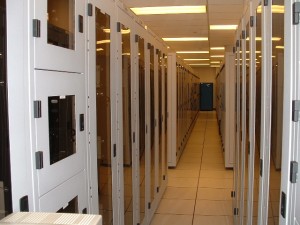
A data center
Note from the editor: This is an article by Jeff Fields. If you’re interested in contributing to Social Web Q and A, check out our guest post guidelines.
In basic terms, cloud computing consists of using a central network of data servers and CPUs with their attendant memory and processing power as a multi-user accessible service instead of a single-user product.
When a cloud is developed, large numbers of computers and data servers are joined together for dramatically increased total processing power and then connected to the outside world via web connections -usually through a web browser.
Other parties can then access the cloud from their own individual computers and rent a little piece of its data storage and processing capacity for their own uses. Thousands or even millions of individual users can work off the same central cloud at the same time–thus creating a much more efficient use of computer time and resources.
Historical Development of Cloud Computing
The original concept behind cloud computing dates all the way back to nearly the earliest days of computer technology in the 1950’s when individual mainframes were extremely expensive and in order to get as much use out of each one as possible, universities and corporations created methods to allow simultaneous use of the same machine through multiple terminals by multiple operators.
However, it wasn’t until the late 1990s and early 2000s that communications technology had developed enough to allow something that more closely resembles the large scale cloud computing we know today.
It was Amazon.com that played one of the key roles in modernizing cloud computing when they launched Amazon Web Services after noticing that their enormous computer data servers were only being used at a small fraction of their potential. With this in mind they began experimenting with allowing small distributed groups of users to access the data servers simultaneously.
From these experiments in the early 2000’s came the development of the first full integrated private use cloud service platforms in 2008. Two pioneers in this field were Eucalyptus and OpenNebula, both of which developed the first API compatible platforms for cloud deployment. It was in that same years that the necessary objective of having a real-time cloud environment was also reached through efforts funded by the European Commission under its RESERVOIR and IRMOS projects.
Cloud Computing Today
Clouds have grown rapidly and extremely quickly since the dawn of the century. Today the cloud platform structure is offered by a whole wash of different providers and these services are in turn used by millions of third parties ranging from corporations to private individuals. Cloud networks range in scope from full integrated Enterprise level systems such as those offered by Oracle and Microsoft.
These include cloud services such as managed services provision, large capacity data server space rental and the provision of cloud-based development environments. On the other hand there are numerous small scale cloud based environments available to millions of individual users. Google Drive, with its document sharing and storage service, is a well-known example of the cloud services that are used by average people.
Other Cloud-based deployment models include Public clouds (such as those provided by Google and Microsoft); Private Clouds, which are deployed inside single organizations or companies through direct connectivity (and example of this being Amazon’s internal server space cloud); and Hybrid Clouds that have been assembled from two or more public/private cloud networks.
The Future of the Cloud
Numerous tech experts–such as the 895 different stakeholders surveyed for the 2012 Fourth Future of the Internet Survey– argue that by the early 2020’s most computer applications, software platforms and data processing work will be conducted over remote access cloud networks instead of through any systems inside personal computers themselves.
This trend should affect personal mobile devices much most of all in an effort to dramatically enhance their capacities while keeping their tiny size. Of course, course, such developments will depend heavily on increased and more reliable 3G and wireless connectivity over much larger areas of the world’s human landscape.
Furthermore, according to current trends, we’ll possibly see a future in which many more devices than just tablets, computers and mobile phones are connected to a whole array of service clouds. Instead there could possibly be clouds of “things” like different household machines, business machines and even vehicles of all kinds, collaborating with each other through cloud based networks and processing greatly expanded applications in the same way. Such advances could dramatically alter the landscape of human communication and productivity in getting things done on both a personal level and in commercial environments.
If cloud developments take off as some of these experts predict, enormous innovation in the field of wireless connectivity and data security will have to also be increased. A cloud lives and dies with the speed and strength of its network connections and such potentially enormous amounts of insecure data and control that exist between clouds and the devices connected to them will be open to catastrophe without solid anti-intrusion security protocols inside the both.
About the author: When Jeff Fields isn’t busy covering the latest and greatest in the tech industry, he spends his time covering the best in ata cases or playing catch with his two teenage sons.
Image: jodax











Speak Your Mind